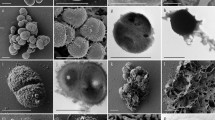Summary
The effects on subcellular morphology of maintaining amoebae at temperatures other than 20 ‡C (the routine culture temperature) were assessed. Estimations of cycling potential at each temperature confirmed that acclimation had affected gross cell functioning. Generation times ranged from no division at 6 ‡C, to an optimal minimum of 2 days at 22 ‡C.
Organelle morphology changes were studied after 5 days of growth at the new temperatures; alterations were most evident at the extremes of 6 and 28 ‡C. The main mitochondrial alteration resulted in changes to the ratio of Type I: Type II organelles; with a decrease in Type I forms away from the optimal range of 20–22 ‡C. Extended culturing at 6 ‡C generated mitochondrial matrical inclusions. Ribosomal attachment to the endoplasmic reticulum, a common feature of 20 ‡C-grown cells, decreased at the temperature extremes, where an increase in free ribosomes occurred. Upon extended culture at 6 ‡C helical structures, usually observed in groups only within the nucleus, were also present in the cytoplasm. Golgi complexes were less common in cells maintained at extreme temperatures and often showed differences in shape. These changes were all reversible on a return to culturing at 20 ‡C.
The possible functional significance of these findings is discussed.
Similar content being viewed by others
References
Ahmad, M., Coulliard, P., 1974: The contractile vacuole ofAmoeba proteus: Temperature effects. J. Protozool.21, 330–336.
Barker, D. C., Swales, L. S., 1972: Comparison of trophozoite helical polysomes with cyst ribosomogen microcrystals in axenicEntamoeba. Cell Differentiation1, 307–315.
Behrens, W. A., Himms-Hagen, J., 1977: Alteration in skeletal muscle mitochondria of cold-acclimated rats: Association with enhanced metabolic response to noradrenaline. J. Bioenerget. Biomem.9, 41–63.
Byers, B., 1967: Structure and formation of ribosome crystals in hypothermic chick embryo cells. J. molec. Biol.126, 155–157.
Caldwell, R. S., Vernberg, F. J., 1970: Influence of acclimation temperature on the lipid composition of fish gill mitochondria. Comp. Biochem. Physiol.34, 179–191.
Cleffman, G., 1967: TemperaturabhÄngigkeit der Phasen des Teilungszyklus vonTetrahymena pyriformis HSM. Z. Zellforsch.79, 599–602.
Craig, N., 1975: Effect of reduced temperatures on protein synthesis in Mouse L cells. Cell4, 329–335.
Daniel, G. E., Chalkley, H. W., 1932: Influence of temperature upon the process of division inAmoeba proteus. J. cell. comp. Physiol.2, 311–327.
Dawson, J. A., Kessler, W. R., Silberstein, J. K., 1937: Mitosis inAmoeba proteus. Biol. Bull.72, 125–144.
De Terra, N., Rustad, R. C., 1959: Dependence of pinocytosis on temperature and aerobic respiration. Exp. Cell Res.17, 191–195.
Flickinger, C. J., 1972: Ribosomal aggregates inAmoebae exposed to the protein synthesis inhibitor emetine. Exp. Cell Res.74, 541–546.
Hannon, J. P., 1960: Effect of prolonged cold exposure on the components of the electron transport chain. Amer. J. Physiol.198, 740–744.
Liesche, W., 1938: Die Kern- und FortpflanzungsverhÄltnisse vonAmoeba proteus. Arch. Protistenk.91, 135–186.
Mast, S. O., Prosser, C. L., 1932: Effect of temperature, salts and hydrogen ion concentration on the rupture of the plasmagel sheet, rate of locomotion and gel/sol ratio inAmoeba proteus. J. cell. comp. Physiol.1, 333–354.
Minassian, I., Bell, L. G. E., 1976: Studies on changes in the nuclear helices ofAmoeba proteus during the cell cycle. J. Cell Sci.20, 273–287.
Ord, M. J., 1970:Amoeba proteus as a cell model in toxicology. In: Mechanisms of Toxicity (Aldridge, W. N., ed.), pp. 175–186. London: Macmillan.
—, 1976: The interaction of nuclear and cytoplasmic damage after treatment with toxic chemicals. J. theor. Biol.62, 369–387.
—, 1978: A capillary technique for cloningAmoeba from single cells. Cytobios21, 57–69.
—, 1979: The effects of chemicals and radiations within the cell: An ultrastructural and micrurgical study usingAmoeba proteus as a single cell model. Int. Rev. Cytol.61, 229–281.
Pace, D. M., Kimura, T. E., 1946: Relation between metabolic activity and cyanide inhibition inPelomyxia carolinensis. Proc. Soc. exp. biol. Med.62, 223–227.
Sisken, J. E., Morasca, L., Kirby, S., 1965: Effects of temperature on the kinetics of mitotic cycle in mammalian cells in culture. Exp. Cell Res.39, 103–116.
Smith, R. A., 1978 a: Studies on the relationship between mitochondrial structure and functioning inAmoeba proteus. Ph.D. Thesis, University of Southampton, England.
—, 1978 b: Diaminobenzidine reactions in control and treatedAmoeba proteus. Histochemistry58, 89–95.
—,Bell, L. G. E., Ord, M. J., 1979: The effects of anaerobiosis and metabolic inhibitors on mitochondrial ultrastructure inAmoeba proteus. Protoplasma99, 275–288.
—,Ord, M. J., 1979: Morphological alterations in the mitochondria ofAmoeba proteus induced by uncoupling agents. J. Cell Sci.37, 217–229.
Sopina, V., 1976: Role of nucleus and cytoplasm in the inheritance of multiplication rates inAmoeba proteus cultured at different temperatures. Exp. Cell Res.97, 259–264.
Stockem, W., Korohoda, W., 1975: Effects of induced pinocytotic activity and extreme temperatures on the morphology of Golgi bodies inAmoeba proteus. Cell Tissue Res.157, 541–552.
Tansakul, R., 1978: The Golgi apparatus and membrane system ofAmoeba proteus. PhD Thesis, University of Southampton, England.
Wojtczak, L., 1976: Effect of long-chain fatty acids and acyl CoA on mitochondrial permeability and energy coupling. J. Bioenerget. Biomem.8, 293–311.
Author information
Authors and Affiliations
Rights and permissions
About this article
Cite this article
Smith, R.A. Growth temperature acclimation byAmoeba proteus: Effects on cytoplasmic organelle morphology. Protoplasma 101, 23–35 (1979). https://doi.org/10.1007/BF01293432
Received:
Accepted:
Issue Date:
DOI: https://doi.org/10.1007/BF01293432



